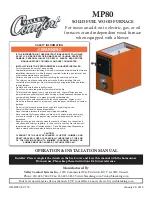
272313-UIM-A-0407
12
Unitary Products Group
ACCESSORY CONNECTIONS
The furnace control will allow power-switching control of various acces-
sories. Refer to Figure 7, for connection details.
ELECTRONIC AIR CLEANER CONNECTION
Two 1/4” (6.4 mm) spade terminals (EAC and NEUTRAL) for electronic
air cleaner connections are located on the control board. The terminals
provide 115 VAC (1.0 amp maximum) during circulating blower opera-
tion.
HUMIDIFIER CONNECTION
Two 1/4” (6.4 mm) spade terminals (HUM and NEUTRAL) for humidifier
connections are located on the control board. The terminals provide 115
VAC (1.0 amp maximum) during heating system operation.
TWINNING
In applications where more heating capacity or more airflow capacity is
needed than what one furnace can deliver, twinning can be used to
make two furnaces operate in tandem. When two furnaces are installed
using the same duct system, it is very important that the two furnace cir-
culating air blowers operate in unison. If one blower starts before the
second blower, the duct system will become pressurized and the blower
on the second furnace will turn backwards causing the second furnace
to overheat, resulting in damage to the furnace. Twinning is used to
make two furnaces operate in tandem, using one duct system, one
room thermostat and causing both furnaces to turn on and off simulta-
neously.
NOTE:
You can twin two furnaces only if they have the same integrated
control board. Check the part number on the integrated control board.
You cannot twin two furnaces that have different integrated control
board part numbers. If the part numbers of the two integrated control
boards are different they may not communicate with each other so they
will not work in a twinning application.
Twinning Duct System
Twinned furnaces must only be applied on a common duct system. A
single air supply plenum must be used for both furnaces and coil(s).
Separate plenums and supply ducts systems cannot be utilized. A sin-
gle return air plenum, common to both furnaces, must be used. It is
suggested that for upflow models, a return platform be utilized, with bot-
tom air entrance into each furnace. If a side entrance returns system is
used, the common return duct must be divided equally so as to supply
each furnace with an equal amount of return air.
Both furnaces must be identical models in both heating capacity and
CFM capacity. Both furnaces must be operated on the same motor
speed taps (low and high, heating and cooling).
IMPORTANT:
When two furnaces are twinned, typical system total air-
flow will be approximately 85% of additive individual furnaces, i.e., two
2000 CFM units will yield a total 3400 CFM.
Gas Piping
Furnace gas supplies must be provided as specified with these instruc-
tions. Since the furnaces are side by side, with no space between, gas
supplies must enter on the right and left respectively. All gas piping
must be in accordance with the national fuel gas code, ANSI Z223.1,
latest edition, and/or all local code or utility requirements.
Single-Wire Twinning
The control in the furnace has the single-wire twinning feature. With this
feature, a single wire is connected between the TWIN terminal on one
furnace board to the TWIN terminal on the second furnace board. The
board then communicates the blower status from one furnace to the
other along this wire. This communication makes the second furnace
blower come on at the same time, and on the same speed, as the first
furnace blower.
Single-wire Twinning Wiring Instructions
Connect the thermostat wiring as shown in the appropriate diagram
below.
It is required that two separate relays be used to isolate the
low voltage systems of the two furnaces.
This isolation will prevent
the possibility of any safety devices being bypassed in an abnormal lim-
iting condition.
Figure 8 below shows control wiring for two furnaces and one single-
speed A/C using a single-stage heat (1H/1C) thermostat. Figure 9
shows control wiring for two furnaces and one single-speed A/C using a
two-stage heat (2H/1C) thermostat. And Figure 10 shows control wiring
for two furnaces and one two-speed A/C using a two-stage heat, two-
stage cool (2H/2C) thermostat. For other configurations, contact techni-
cal services.
NOTE:
The twinned furnaces must be connected to the same leg of the
line voltage to prevent phasing error problems. If this is not done prop-
erly, the furnaces will not operate and the control board LEDs will flash
a rapid red flash to indicate the twinning error.
Using a Single-stage Heat Thermostat with Twinned Two-stage
Furnaces
- These furnaces may be twinned using a single-stage (1H)
or two-stage (2H) wall thermostat. When using a 1H thermostat, con-
nect the low-voltage wiring as shown in Figure 8. Place the "W2 Delay"
jumper in the same position of both furnace control boards. If the
jumper is left in the "OFF" position, the furnaces will operate only at low
fire.
FIGURE 7:
Accessory Connections
Before installing the relay and wiring, disconnect electrical power to
both furnaces. Failure to cut power could result in electrical shock
or equipment damage.
The relay must not be installed in any location where it could be
exposed to water. If the relay has been exposed to water in any
way, it must not be used.
115 VOLT
HUMIDIFER
115 VOLT
ELECTRONIC
AIR CLEANER
EAC HOT
HUM. HOT
BLK
WHT
EAC
HUM
NEUTRALS
SWITCHED
CIRCUITS
BLK
WHT
If a return duct is connected to only one furnace (with a connection
between the two furnaces) an imbalance in the airflow will occur
and the furnace farthest from the return plenum will overheat.













































